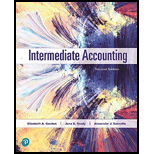
Intermediate Accounting (2nd Edition)
2nd Edition
ISBN: 9780134730370
Author: Elizabeth A. Gordon, Jana S. Raedy, Alexander J. Sannella
Publisher: PEARSON
expand_more
expand_more
format_list_bulleted
Question
Chapter 15, Problem 1BCC
a.
To determine
To explain: The treatment of financial instrument under US GAAP and IFRS.
b.
To determine
To explain: The rationale of each standard setting body.
c.
To determine
To explain: The trade off with respect to bifurcation and which view is most preferable.
Expert Solution & Answer
Want to see the full answer?
Check out a sample textbook solution
Students have asked these similar questions
Explain the difference between accrued expense and prepaid expense with examples. Need help
Explain the difference between accrued expense and prepaid expense with examples.
Which financial statement shows financial position at a point in time? Help
Chapter 15 Solutions
Intermediate Accounting (2nd Edition)
Ch. 15 - Prob. 15.1QCh. 15 - What are the retained earnings of a firm?Ch. 15 - Prob. 15.3QCh. 15 - Prob. 15.4QCh. 15 - Does an entity have to legally dissolve treasury...Ch. 15 - Prob. 15.6QCh. 15 - Prob. 15.7QCh. 15 - Prob. 15.8QCh. 15 - Prob. 15.9QCh. 15 - Prob. 15.10Q
Ch. 15 - Prob. 15.11QCh. 15 - Do firms often use stock dividends to avoid...Ch. 15 - Prob. 15.13QCh. 15 - What is included in other comprehensive income?Ch. 15 - Is a specific format required for reporting...Ch. 15 - Prob. 15.16QCh. 15 - Boone Corporations outstanding capital stock on...Ch. 15 - Prob. 15.2MCCh. 15 - Prob. 15.3MCCh. 15 - Prob. 15.4MCCh. 15 - Prob. 15.5MCCh. 15 - Prob. 15.6MCCh. 15 - Prob. 15.7MCCh. 15 - Prob. 15.1BECh. 15 - Stockholders Equity Terminology, U.S. GAAP, IFRS....Ch. 15 - Common Stock Issuance, No Par Value. Perdido...Ch. 15 - Prob. 15.4BECh. 15 - Prob. 15.5BECh. 15 - Prob. 15.6BECh. 15 - Prob. 15.7BECh. 15 - Prob. 15.8BECh. 15 - Treasury Stock Transactions. Ginger Spice...Ch. 15 - Treasury Stock Transactions. On March 15, Chief...Ch. 15 - Treasury Stock Transactions, Retirement. Using the...Ch. 15 - Prob. 15.12BECh. 15 - Prob. 15.13BECh. 15 - Prob. 15.14BECh. 15 - Common Stock Issuance, Stated Value, Issue Costs....Ch. 15 - Common Stock Issuance. Par Value, Issue Costs,...Ch. 15 - Prob. 15.3ECh. 15 - Prob. 15.4ECh. 15 - Prob. 15.5ECh. 15 - Treasury Stock Transactions, Retirement,...Ch. 15 - Treasury Stock Transactions, Disclosure. The...Ch. 15 - Treasury Stock Transactions. Several years ago,...Ch. 15 - Prob. 15.9ECh. 15 - Prob. 15.10ECh. 15 - Prob. 15.11ECh. 15 - Prob. 15.12ECh. 15 - Preferred Stock Issuance Dividends, Disclosure....Ch. 15 - Prob. 15.14ECh. 15 - Prob. 15.15ECh. 15 - Prob. 15.16ECh. 15 - Prob. 15.17ECh. 15 - Prob. 15.18ECh. 15 - Prob. 15.19ECh. 15 - Prob. 15.20ECh. 15 - Prob. 15.21ECh. 15 - Prob. 15.22ECh. 15 - Prob. 15.1PCh. 15 - Prob. 15.2PCh. 15 - Prob. 15.3PCh. 15 - Prob. 15.4PCh. 15 - Prob. 15.5PCh. 15 - Common Stock Issuance, Treasury Stock, Dividends,...Ch. 15 - Prob. 15.7PCh. 15 - Prob. 15.8PCh. 15 - Prob. 15.9PCh. 15 - Prob. 1JCCh. 15 - Judgment Case 2: Impact of Judgment in Accounting...Ch. 15 - Surfing the Standards Cases Surfing the Standards...Ch. 15 - Prob. 1BCCCh. 15 - Prob. 2BCC
Knowledge Booster
Similar questions
- Please explain the solution to this general accounting problem with accurate explanations.arrow_forwardI am looking for the correct answer to this general accounting question with appropriate explanations.arrow_forwardWhich financial statement shows financial position at a point in time?arrow_forward
- I need guidance with this general accounting problem using the right accounting principles.arrow_forwardPlease provide the accurate answer to this general accounting problem using valid techniques.arrow_forwardCan you explain the correct approach to solve this general accounting question?arrow_forward
arrow_back_ios
SEE MORE QUESTIONS
arrow_forward_ios
Recommended textbooks for you
- Principles of Accounting Volume 1AccountingISBN:9781947172685Author:OpenStaxPublisher:OpenStax College
 Financial Reporting, Financial Statement Analysis...FinanceISBN:9781285190907Author:James M. Wahlen, Stephen P. Baginski, Mark BradshawPublisher:Cengage Learning
Financial Reporting, Financial Statement Analysis...FinanceISBN:9781285190907Author:James M. Wahlen, Stephen P. Baginski, Mark BradshawPublisher:Cengage Learning  Auditing: A Risk Based-Approach to Conducting a Q...AccountingISBN:9781305080577Author:Karla M Johnstone, Audrey A. Gramling, Larry E. RittenbergPublisher:South-Western College Pub
Auditing: A Risk Based-Approach to Conducting a Q...AccountingISBN:9781305080577Author:Karla M Johnstone, Audrey A. Gramling, Larry E. RittenbergPublisher:South-Western College Pub

Principles of Accounting Volume 1
Accounting
ISBN:9781947172685
Author:OpenStax
Publisher:OpenStax College


Financial Reporting, Financial Statement Analysis...
Finance
ISBN:9781285190907
Author:James M. Wahlen, Stephen P. Baginski, Mark Bradshaw
Publisher:Cengage Learning

Auditing: A Risk Based-Approach to Conducting a Q...
Accounting
ISBN:9781305080577
Author:Karla M Johnstone, Audrey A. Gramling, Larry E. Rittenberg
Publisher:South-Western College Pub